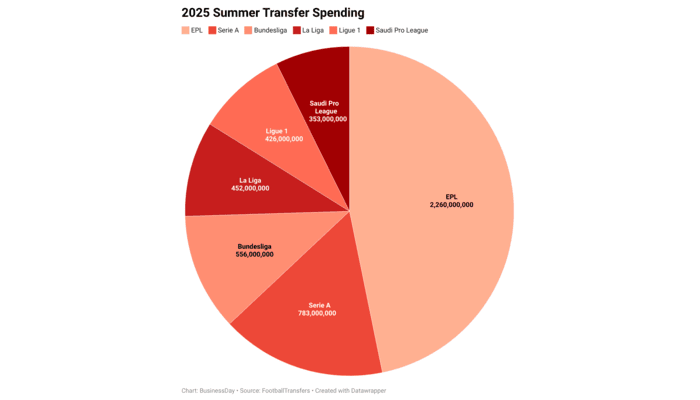Premier League clubs are on the verge of setting a new record for summer transfer spending, having already invested £2.26 billion, according to data from FootballTransfers as published on BBC Sport.
This marks a 12.7% increase on the £1.97 billion spent in summer 2024. The all-time record, however, still remains the £2.36 billion set in the 2023 window, a figure that now looks certain to be surpassed before the deadline.
With the transfer window open until September 1, a new record seems all but certain. Several major deals have already been completed, with Liverpool, Chelsea, and Manchester United being the top spenders.
The arrivals of players like Florian Wirtz to Liverpool and Bryan Mbeumo and Benjamin Sesko to Manchester United have pushed the collective spending past the £2 billion mark for the first time.
While top clubs have led the spending spree, the financial landscape has also seen clubs like Aston Villa generate significant income from player sales, helping them with their financial fair play (FFP) standing. With just days remaining until the deadline, more deals are expected, which will surely push the total spending past the previous record.

Premier League Spending Outpaces the Rest of Europe Combined
Premier League clubs are once again dominating the transfer market, spending more than Serie A, Bundesliga, Ligue 1, and La Liga combined during the current summer window.
According to the latest figures, English top-flight sides have already spent £1bn more than they have recouped in sales, underlining their financial power. The only other top European league with a negative net spend is La Liga, where clubs have invested just £35m more than they have generated in outgoing transfers.
Premier League Driving Europe’s Transfer Economy
Unsurprisingly, the Premier League’s wealth is fuelling sales across the continent, with Bundesliga clubs in particular cashing in. The three biggest signings so far this summer have all involved players moving from Germany to England:
Florian Wirtz – Bayer Leverkusen to Liverpool, £100m rising to £116m with add-ons
Hugo Ekitike – Eintracht Frankfurt to Liverpool, £69m rising to £79m
Benjamin Šeško – RB Leipzig to Manchester United, £66.3m rising to £73.7m
While Serie A is the next biggest spender outside the Premier League with £783m, that figure is still less than the Premier League’s net spend alone, further highlighting the gulf in financial muscle.

Record-Breaking Window Incoming?
With the deadline fast approaching, spending shows no signs of slowing down. The future of Newcastle striker Alexander Isak, valued at £150m and targeted by Liverpool, remains uncertain, while several other big names could yet move before September 1.
Among those linked with late transfers are Marc Guéhi and Eberechi Eze of Crystal Palace, Yoane Wissa of Brentford, Alejandro Garnacho of Manchester United, and Chelsea’s duo Nicolas Jackson and Christopher Nkunku.
If further big-money deals go through, the £2.5bn barrier could be smashed, setting yet another record for Premier League dominance in the transfer market.
Clubs That Have Broken Their Transfer Records This Summer
The 2025 summer transfer window has seen several Premier League clubs break their transfer records as the spending spree continues to escalate.
Brentford set a new benchmark with the signing of Burkina Faso forward Dango Ouattara from Bournemouth in a deal worth up to £42.5m, surpassing their previous record. Bournemouth themselves raised their bar earlier in the window, paying £34.6m for French centre-back Bafodé Diakité.
Newly promoted clubs have also made history. Burnley spent a club-record £25m on French midfielder Lesley Ugochukwu, while Sunderland sealed a £26m deal for Senegal international Habib Diarra, which could rise to £30m with add-ons.
Nottingham Forest have broken their transfer record twice in a single summer, first with the arrival of Switzerland winger Dan Ndoye from Bologna, before eclipsing that figure with the signing of Omari Hutchinson from Ipswich for £37.5m.
At the top end of the market, Liverpool shattered their transfer record by signing Florian Wirtz from Bayer Leverkusen for a guaranteed £100m, with a further £16m in add-ons. If triggered, the deal would not only be Liverpool’s record but also a new British transfer record, surpassing Chelsea’s £107m move for Enzo Fernández in 2023.
Transfer Records Across the Premier League
Of the 20 current Premier League clubs, 16 have broken their transfer record in the past four years, underlining the financial scale of the league. Four clubs, Chelsea, Liverpool, Manchester City, and Arsenal, now have transfer records above £100m.
At the other end of the spectrum, Burnley’s record signing remains their £25m move this summer, while some long-standing records persist. Despite spending around £200m on players this window, Manchester United’s record signing is still Paul Pogba’s £91m move from Juventus in 2016. Similarly, Crystal Palace’s record remains the £27m paid for Christian Benteke in the same year.
Atletico, Real Madrid Lead European Spending Outside Premier League
In La Liga, Serie A, the Bundesliga and Ligue 1, only Atletico Madrid and Real Madrid have spent more than £140m on players this summer. Atletico top the list outside England with £153m, closely followed by Real on £147m.
Those sums are far below the reported £289.5m Liverpool have invested in their squad since being crowned Premier League champions, more than three times the outlay of Paris Saint-Germain (PSG), who have spent £90m since winning the Champions League.
Elsewhere across Europe, Juventus have spent £103m, Bayer Leverkusen £100m, RB Leipzig £98m, and AC Milan £93m. In contrast, Barcelona have spent just £22.5m so far this summer.
The biggest transfer outside the Premier League remains Luis Díaz’s £65.5m move from Liverpool to Bayern Munich, including add-ons.
2025 Outlook
With more high-profile deals expected and the futures of several top players still unresolved, the £2.36bn barrier looks certain to fall before September 1.
If confirmed, the 2025 summer transfer window would officially become the biggest spending window in Premier League history, further cementing the league’s dominance in the global football economy.









